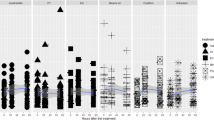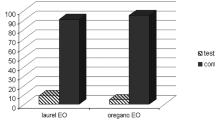Abstract
Kaolin particle films and copper-based products can be considered as possible alternatives to traditional agrochemicals used for controlling the dominant pest of olive grove areas of the Mediterranean Basin, the olive fruit fly, Bactrocera oleae (Rossi) (Dip. Tephritidae), to which this pest has already evolved resistance. Psyttalia concolor (Szèpligeti) (Hym. Braconidae) is a koinobiont larval–pupal endoparasitoid of many Tephritidae of economic importance. It has been routinely used in the Mediterranean Basin for augmentative releases against B. oleae. Detailed knowledge of lethal and sublethal effects of these agrochemicals on non target arthropods is required for effective integrated pest management programmes. The aims of this study were to evaluate direct mortality caused by kaolin and copper salts on the parasitoid and the sublethal effects on emergence of adults from treated pupae and on beneficial capacity of females through four different experiments, three at laboratory level and one in semi-field conditions. Dual choice and no-choice experiments in the case of kaolin were also performed to test kaolin oviposition repellence. The results indicated that the tested agrochemicals were not harmful to the parasitoid. No lethal toxicity or effects on beneficial capacity were recorded. The behavioural experiments, however, showed that when females could choose between parasitising through a kaolin-treated surface and a water-treated one, there was a slight reduction in the percentage of parasitised hosts for kaolin. No differences were detected when females were not given a choice.

Similar content being viewed by others
References
Adán A, González T, Bastante R, Budia F, Medina P, Del Estal P, Viñuela E (2007) Efectos de diversos insecticidas aplicados en condiciones de laboratorio extendido sobre Psyttalia concolor (Szèpligeti) (Hymenoptera: Braconidae). Bol San Veg Plagas 33:391–397
Belcari A, Bobbio E (1999) The use of copper in the control of the olive fly, Bactrocera oleae. Informatore Fitopatologico 49:52–55
Belcari A, Sacchetti P, Rosi MC, Pianta RD (2005) The use of copper-based products to control the olive fly (Bactrocera oleae) in central Italy. “Integrated Protection of Olive Crops”. IOBC/wprs Bull 28(9):45–48
Benelli G, Canale A (2012) Learning of visual cues in the fruit fly parasitoid Psyttalia concolor (Szèpligeti) (Hymenoptera: Braconidae). Biocontrol 57:767–777
Benelli G, Bonsignori G, Stefanini C, Canale A (2012) Courtship and mating behaviour in the fruit fly parasitoid (Szèpligeti) (Hymenoptera: Braconidae): the role of wing fanning. J Pest Sci 85:55–63
Benelli G, Gennari G, Canale A (2013a) Host discrimintation ability in the tephritid parasitoid Psyttalia concolor (Hymenoptera: Braconidae). J Pest Sci 86:245–251
Benelli G, Revadi S, Carpita A, Giunti G, Raspi A, Anfora G, Canale A (2013b) Behavioral and electrophysiological responses of the parasitic wasp Psyttalia concolor (Szèpligeti) (Hymenoptera: Braconidae) to Ceratitis capitata-induced fruit volatiles. Biol Control 64:116–124
Bengochea P, Hernando S, Saelices R, Adán A, Budia F, González-Núñez M, Viñuela E, Medina P (2010) Side effects of kaolin on natural enemies found on olive crops. IOBC/wprs Bull 55:61–67
Bengochea P, Christiaens O, Amor F, Viñuela E, Rougé P, Medina P, Smagghe G (2012) Ecdysteroid receptor docking suggests that dibenzoylhydrazine-based insecticides are devoid to any deleterious effect on the parasitic wasp Psyttalia concolor (Hym. Braconidae). Pest Manag Sci 68(7):976–985
Bengochea P, Amor F, Saelices R, Hernando S, Budia F, Adán A, Medina P (2013) Kaolin and copper-based products: ecotoxicology on four natural enemies. Chemosphere 91(8):1189–1195
Biondi A, Mommaerts V, Smagghe G, Viñuela E, Zappalà L, Desneux N (2012) The non-target impact of spinosyns on beneficial arthropods. Pest Manag Sci 68(2):1523–1536
Bürgel K, Daniel C, Wyss E (2005) Effects of autumn kaolin treatments on the rosy apple aphid, Dysaphis plantaginea (Pass.) and possible modes of action. J Appl Entomol 129(6):311–314
Canale C, Benelli G (2012) Impact of mass-rearing on the host seeking behaviour and parasitism by the fruit fly parasitoid Psyttalia concolor (Szèpligeti) (Hymenoptera: Braconidae). J Pest Sci 85:65–74
Daane KM, Johnson MW (2010) Olive fruit fly: managing an ancient pest in modern times. Annu Rev Entomol 55:151–169
Daniel C, Pfammatter W, Kehrli P, Wyss E (2005) Processed kaolin as an alternative insecticide against the European pear sucker, Cacopsylla pyri (L.). J Appl Entomol 129(7):363–367
Desneux N, Decourtye A, Delpuech JM (2007) The sublethal effects of pesticides on beneficial organisms. Annu Rev Entomol 52:81–106
EPPO (European and Mediterranean Organization of Plant Protection Organization) 2013. Successfully introduced classical biological control agents. Insecta, Hymenoptera (part II). http://archives.eppo.int/EPPOStandards/biocontrol_web/classical/hymen2_class.htm. Accessed 4 Oct 2013)
Garcia VP, Pereira N, Oliveira L (2009) Side-effects of organic and synthetic pesticides on cold-stored diapausing prepupae of Trichogramma cordubensis. Biocontrol 54:451–458
Glenn DM, Puterka GJ, Vanderzwet T, Stern RE, Feldmhake C (1999) Hydrophobic particle films: a new paradigm for suppression of arthropod pests and plant diseases. J Econ Entomol 92(4):759–771
González-Núñez M, Bahena F, Viñuela E (1998) Desarrollo de un método de semicampo para estudio de los efectos secundarios de los productos fitosanitarios sobre el parasitoide Opius concolor Szèpligeti. Bol San Veg Plagas 24:661–668
González-Núñez M, Pascual S, Seris E, Esteban-Durán JR, Medina P, Budia F, Adán A, Viñuela E (2008) Effects of different control measures against the olive fruit fly (Bactrocera oleae (Gmelin)) on beneficial arthropofauna. Methodology and first results of field assays. IOBC/wprs Bull 35:26–31
Haniotakis GE (2005) Olive pest control: present status and prospects. Integrated protection of olive crops. IOBC/WPRS Bull 28:1–9
Jacas JA, Viñuela E (1994) Analysis of a lab method to test the effects of pesticides on adult females of Opius concolor, a parasitoid of the olive fruit fly Bactrocera oleae. Biocontrol Sci Technol 4:147–154
Kakani EG, Zygouridi NE, Tsouman KT, Seraphide N, Zalo FG, Mathiopoulo KD (2010) Spinosad resistance development in wild olive fruit fly Bactrocera oleae (Diptera: Tephritidae) populations in California. Pest Manag Sci 66:447–453
Kimani-Njogu SW, Trostle MK, Wharton RA, Woodelley JB, Raspi A (2001) Biosistematics of the Psyttalia concolor species complex (Hymenoptera: Braconidae: Opiinae): the identity of populations attacking Ceratitis capitata (Diptera: Tephritidae) in coffee in Kenya. Biol Control 20:167–174
Kourdoumbalos AK, Margaritopoloulos JT, Nanos GD, Tsitsipis JA (2006) Alternative aphid control methods for peach production. J Fruit Ornam Plant Res 14(3):181–190
Medina P, Budia F, Rodriguez B, González M, Diaz A, Huerta A, Zapata N, Viñuela E (2006) Effects of botanical insecticides on two natural enemies of importance in Spain: Chrysoperla carnea (Stephens) and Psyttalia concolor (Szépligeti). IOBC/wprs Bull 29:85–93
Medina P, Corrales E, González-Núñez M, Smagghe G, Viñuela E (2008) Effects of Beauveria bassiana, Heterorhabditis bacteriophora, H. megidis and Sterinernema feltiae on the Mediterranean fruit fly Ceratitis capitata and the very sensitive braconid Psyttalia concolor. IOBC/wprs Bull 35:113–121
Pascual S, Sánchez-Ramos I, González-Núñez M (2010a) Repellent/deterrent effect of kaolin and copper on Bactrocera oleae oviposition in the laboratory. IOBC/wprs Bull 59:83–88
Pascual S, Cobos G, Seris E, González-Núñez M (2010b) Effects of processed kaolin on pests and non-target arthropods in a Spanish olive grove. J Pest Sci 83:121–133
Pasqualini E, Civolani S, Grappadelli LC (2003) Particle film technology: approach for biorational control of Cacopsylla pyri (Rhynchota Psyllidae) in north Italy. Bull Insectol 55:39–42
Porcel M, Cotes B, Campos M (2011) Biological and behavioural effects of kaolin particle film on larvae and adults of Chrysoperla carnea (Neuroptera: Chrysopidae). Biol Control 59(2):98–105
Rosi MC, Sacchetti P, Librandi M, Belcari A (2007) Effectiveness of different copper products against the olive fly in organic olive groves. Integrated protection of olive crops. IOBC/wprs Bull 30(9):277–281
Rugman-Jones PF, Wharton R, van Noort T, Stouthamer R (2009) Molecular differenciation of the Psyttalia concolor (Szépligeti) species complex (Hymenoptera: Braconidae) associated with olive fly, Bactrocera oleae (Rossi) (Diptera: Tephritidae), in Africa. Biol Control 49:17–26
Ruiz-Torres M, Montiel-Bueno A (2007) Eficacia de los tratamientos mediante árboles cebo contra la mosca del olivo (Bactrocera oleae Gmel; Tephritidae, Diptera) en la provincia de Jaén. Bol San Veg Plagas 33:249–265
Sackett TE, Buddle CM, Vincent C (2007) Effects of kaolin on the composition of generalist predator assemblages and parasitism of Choristoneura rosaceana (Lep., Tortricidae) in apple orchards. J Appl Entomol 131(7):478–485
Saour G, Makee H (2004) A kaolin based particle film for supression of the olive fruit fly Bactrocera oleae Gmelin (Dip., Tephritidae) in olive groves. J Appl Entomol 128:28–31
Scalercio S, Belfiore T, Noce ME, Vizzarri V, Iannotta N (2009) The impact of compounds allowed in organic farming on the above-ground arthropods of the olive ecosystem. Bull Insectol 62(2):137–141
Showler A (2003) Effects of kaolin particle film on beet armyworm, Spodoptera exigua (Hübner) (Lepidoptera: Noctuidae), oviposition, larval feeding and development on cotton, Gossypium hirsutum L. Agr Ecosyst Environ 95:265–271
Silva CAD, Ramalho FS (2013) Kaolin spraying protects cotton plants against damages by boll weevil Anthonomus grandis Boheman (Coleoptera: Curculionidae). J Pest Sci 86:563–569
Sterk G, Hassan SA, Baillod M, Bakker F, Bigler F, Blümel S, Bogenschütz H, Boller E, Bromand B, Brun J, Calis JNM, Coremans-Pelseneer J, Duso C, Garrido A, Grove A, Heimbach U, Hokkanen H, Jacas J, Lewis G, Moreth L, Polgar L, Rovesti L, Samsoe-Petersen L, Sauphanor B, Schaub L, Staübli A, Tuset JJ, Vainio A, Van De Veire M, Viggiani G, Viñuela E, Vogt H (1999) Results of the seventh joint pesticide testing programme carried out by The IOBC/wprs Working Group Pesticides and Beneficials. Biocontrol 44:99–117
STSC (1987) Statgraphics user’s guide, Version 5.1. Graphic software system, STSC, Rockville
Vanaclocha P, Vidal-Quist C, Oheix S, Montón H, Planes L, Catalán J, Tena A, Verdú MJ, Urbaneja A (2013) Acute toxicity in laboratory tests of fresh and aged residues of pesticides used in citrus on the parasitoid Aphitis melinus. J Pest Sci 86:329–336
Villanueva-Jiménez JA, Hoy MA (1998) Toxicity of pesticides to the citrus leafminer and its parasitoid Ageniaspis citricola evaluated to assess their suitability for an IPM program in citrus nurseries. Biocontrol 43:357–388
Viñuela E, Adán A, Smagghe G, Gonzalez M, Medina P, Budia F, Vogt H, Del Estal P (2000) Laboratory effects of ingestion of azadirachtin by two pests (Ceratitis capitata and Spodoptera exigua) and three natural enemies (Chrysoperla carnea, Opius concolor and Podisus maculiventris). Biochem Sci Technol 10:165–177
Viñuela E, Medina MP, Schneider M, González M, Budía F, Adán A, Del Estal P (2001) Comparison of side-effects of spinosad, tebufenozide and azadirachtin on the predators Chrysoperla carnea and Podisus maculiventris and the parasitoids Opius concolor and Hyposoter didymator under laboratory conditions. IOBC/wprs Bull 24(4):25–34
Vontas J, Hernández-Crespo P, Margaritopoulos JT, Ortego F, Feng H-T, Hsu J-C (2011) Insecticide resistance in Tephritid flies. Pest Biochem Phys 100(3):199–205
Ye GY, Dong SZ, Dong H, Hu C, Shenn ZC, Cheng JA (2009) Effects of host (Boettcherisca peregrina) copper exposure on development, reproduction and vitellogenesis of the ectoparasitic wasp, Nasonia vitripennis. Insect Sci 16:43–50
Yee WL (2007) Effects of several newer insecticides and kaolin on oviposition and adult mortality in western cherry fruit fly (Diptera: Tephritidae). J Entomol Sci 43(2):177–190
Yee WL (2012) Behavioral responses by Rhagoletis indifferens (Dip. Tephritidae) to sweet cherry treated with kaolin- and limestone-based products. J Appl Entomol 136(1–2):124–132
Youssef AI, Nasr FN, Stefanos SS, Elkhair SSA, Shehata WA, Herz AE, Hassan SA (2004) The side-effects of plant protection products used in olive cultivation on the hymenopterous egg parasitoid Trichogramma cacoeciae Marchal. J Appl Entomol 128(9–10):593–599
Acknowledgements
This work was supported by the Spanish Ministry of Science and Innovation (project AGL 2007-66130-C03-02 to P. Medina). Paloma Bengochea acknowledges Technical University of Madrid (UPM) for a pre-doctoral grant.
Author information
Authors and Affiliations
Corresponding author
Additional information
Communicated by A. Biondi.
Rights and permissions
About this article
Cite this article
Bengochea, P., Budia, F., Viñuela, E. et al. Are kaolin and copper treatments safe to the olive fruit fly parasitoid Psyttalia concolor?. J Pest Sci 87, 351–359 (2014). https://doi.org/10.1007/s10340-013-0543-5
Received:
Accepted:
Published:
Issue Date:
DOI: https://doi.org/10.1007/s10340-013-0543-5




